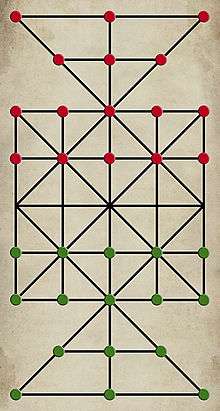Sixteen Soldiers
Sixteen Soldiers is a two-player abstract strategy board game from Sri Lanka. It also comes from India under the name Cows and Leopards. A variant of this game is also popular in Bangladesh, where it is known as Sholo guti (Sixteen pieces). The game is similar to draughts and Alquerque as players hop over one another's pieces to capture them. However, unlike draughts and standard Alquerque, the game is played on an expanded Alquerque board consisting of four triangular boards attached to the four sides of an Alquerque board. Also, pieces can move and capture in any direction from the beginning. There is no promotion to King. Its actual closest relatives are Peralikatuma and Kotu Ellima which are also from the Indian subcontinent. The only real difference between these three closely related games is the number of pieces. In Sixteen Soldiers, each player has 16 pieces hence the name of the game. In Peralikatuma, each player has 23 pieces. In Kotu Ellima, each player has 24 pieces. Sixteen Soldiers is also related to the Indonesian game of Permainan-Tabal.
In Sholo guti, players can agree beforehand the number of opposing pieces to be captured to win the game. It does not necessarily have to be all 16 pieces of the opposing player. It can be 15 or 14 or 11 as an example.
Goal
The player who captures all the other player's pieces wins. In the case of Sholo guti, the number of opposing pieces to be captured that both players agree upon.
Equipment

An expanded Alquerque board is used. Four triangle boards are attached to the center of the four sides of an Alquerqe board. Each player has 16 pieces.[1] One player has the white pieces, and the other has the black pieces, however, any two colors or distinguishable objects will do. Pieces are played on the intersection points of the board.
Game Play and Rules
1. Players decide what colors to play, and who starts first. Players alternate their turns, and only use one piece to either move or capture per turn.
2. Each players pieces are initially set up on the first four ranks of their side of the board.
3. A piece moves one space per turn in any direction following the pattern on the board onto an unoccupied point on the board.
4. A piece can capture an enemy piece in any direction by the short leap as in draughts or Alquerque. The player's piece must be adjacent to the enemy piece, and leap over it onto a vacant point on the other side. The leap must be in a straight line following the pattern on the board. The same piece can continue to capture and even change direction to capture provided capturing requirements are satisfied. Captures are compulsory. A piece must continue to capture if it is able to do so. Captured pieces are removed from the board.
5. If a player does not capture any enemy piece during their turn, but was actually able to do so, then the other player removes that piece that failed to make its capture from the board. If there is more than one piece to choose from, any one will do. The piece is said to be "huffed", and then removed.
6. If a player has more than one option to capture, then the player can choose any one (and only one) of them.
Related Games
Peralikatuma, Kotu Ellima, Permainan-Tabal, draughts, Alquerque
